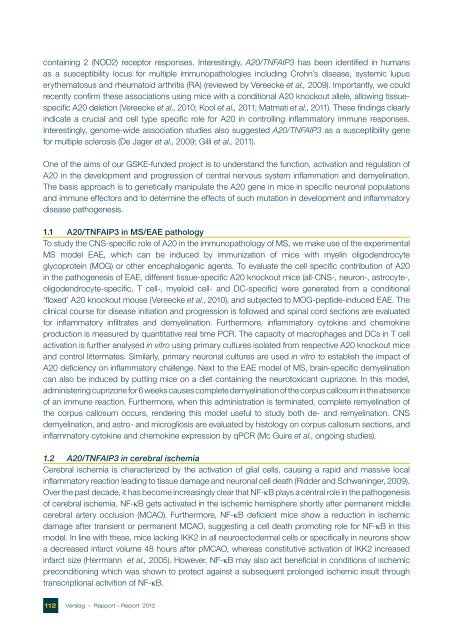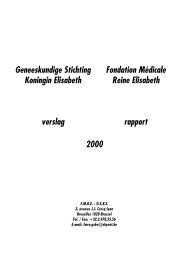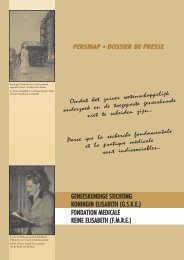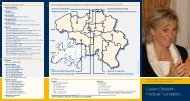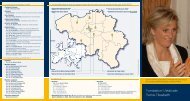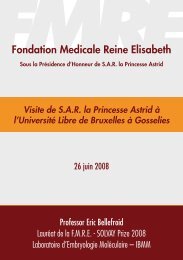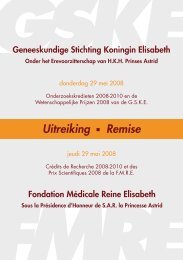Verslag – Rapport – Bericht – Report - GSKE - FMRE
Verslag – Rapport – Bericht – Report - GSKE - FMRE
Verslag – Rapport – Bericht – Report - GSKE - FMRE
Create successful ePaper yourself
Turn your PDF publications into a flip-book with our unique Google optimized e-Paper software.
containing 2 (NOD2) receptor responses. Interestingly, A20/TNFAIP3 has been identified in humans<br />
as a susceptibility locus for multiple immunopathologies including Crohn’s disease, systemic lupus<br />
erythematosus and rheumatoid arthritis (RA) (reviewed by Vereecke et al., 2009). Importantly, we could<br />
recently confirm these associations using mice with a conditional A20 knockout allele, allowing tissuespecific<br />
A20 deletion (Vereecke et al., 2010; Kool et al., 2011; Matmati et al., 2011). These findings clearly<br />
indicate a crucial and cell type specific role for A20 in controlling inflammatory immune responses.<br />
Interestingly, genome-wide association studies also suggested A20/TNFAIP3 as a susceptibility gene<br />
for multiple sclerosis (De Jager et al., 2009; Gilli et al., 2011).<br />
One of the aims of our <strong>GSKE</strong>-funded project is to understand the function, activation and regulation of<br />
A20 in the development and progression of central nervous system inflammation and demyelination.<br />
The basis approach is to genetically manipulate the A20 gene in mice in specific neuronal populations<br />
and immune effectors and to determine the effects of such mutation in development and inflammatory<br />
disease pathogenesis.<br />
1.1 A20/TNFAIP3 in MS/EAE pathology<br />
To study the CNS-specific role of A20 in the immunopathology of MS, we make use of the experimental<br />
MS model EAE, which can be induced by immunization of mice with myelin oligodendrocyte<br />
glycoprotein (MOG) or other encephalogenic agents. To evaluate the cell specific contribution of A20<br />
in the pathogenesis of EAE, different tissue-specific A20 knockout mice (all-CNS-, neuron-, astrocyte-,<br />
oligodendrocyte-specific, T cell-, myeloid cell- and DC-specific) were generated from a conditional<br />
‘floxed’ A20 knockout mouse (Vereecke et al., 2010), and subjected to MOG-peptide-induced EAE. The<br />
clinical course for disease initiation and progression is followed and spinal cord sections are evaluated<br />
for inflammatory infiltrates and demyelination. Furthermore, inflammatory cytokine and chemokine<br />
production is measured by quantitative real time PCR. The capacity of macrophages and DCs in T cell<br />
activation is further analysed in vitro using primary cultures isolated from respective A20 knockout mice<br />
and control littermates. Similarly, primary neuronal cultures are used in vitro to establish the impact of<br />
A20 deficiency on inflammatory challenge. Next to the EAE model of MS, brain-specific demyelination<br />
can also be induced by putting mice on a diet containing the neurotoxicant cuprizone. In this model,<br />
administering cuprizone for 6 weeks causes complete demyelination of the corpus callosum in the absence<br />
of an immune reaction. Furthermore, when this administration is terminated, complete remyelination of<br />
the corpus callosum occurs, rendering this model useful to study both de- and remyelination. CNS<br />
demyelination, and astro- and microgliosis are evaluated by histology on corpus callosum sections, and<br />
inflammatory cytokine and chemokine expression by qPCR (Mc Guire et al., ongoing studies).<br />
1.2 A20/TNFAIP3 in cerebral ischemia<br />
Cerebral ischemia is characterized by the activation of glial cells, causing a rapid and massive local<br />
inflammatory reaction leading to tissue damage and neuronal cell death (Ridder and Schwaninger, 2009).<br />
Over the past decade, it has become increasingly clear that NF-kB plays a central role in the pathogenesis<br />
of cerebral ischemia. NF-kB gets activated in the ischemic hemisphere shortly after permanent middle<br />
cerebral artery occlusion (MCAO). Furthermore, NF-kB deficient mice show a reduction in ischemic<br />
damage after transient or permanent MCAO, suggesting a cell death promoting role for NF-kB in this<br />
model. In line with these, mice lacking IKK2 in all neuroectodermal cells or specifically in neurons show<br />
a decreased infarct volume 48 hours after pMCAO, whereas constitutive activation of IKK2 increased<br />
infarct size (Herrmann et al., 2005). However, NF-kB may also act beneficial in conditions of ischemic<br />
preconditioning which was shown to protect against a subsequent prolonged ischemic insult through<br />
transcriptional activition of NF-kB.<br />
112<br />
<strong>Verslag</strong> <strong>–</strong> <strong>Rapport</strong> <strong>–</strong> <strong>Report</strong> 2012


